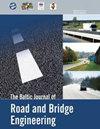沥青路面新匈牙利力学-经验设计程序
IF 1.1
4区 工程技术
Q4 ENGINEERING, CIVIL
引用次数: 7
摘要
目前使用的匈牙利路面设计方法的某些要素是以机械经验路面设计原则为基础的,尽管它们在实践中并不总是容易执行。在设计新的路面结构时,只能从目录中选择预先确定的成分。使用匈牙利设计目录无疑是舒适的,但现在特殊要求(如经济,可持续性)也已制定。这些要求越来越要求发展一种可以在匈牙利条件下使用的方法,这种方法可以提供各种材料特性的使用。它需要的不是提供一个预定义的解决方案,而是为设计人员提供一个有用的工具,以便对工程方案进行现实的比较。本文介绍了一项正在进行的研究的结果,旨在为新建沥青路面的设计提供一种替代程序。与使用预定设计相比,它为更好地表征天然路基和路面层的材料特性建立了框架。它还提供了考虑当地、环境、地理和其他条件以及创新建筑和技术能力的机会。本文章由计算机程序翻译,如有差异,请以英文原文为准。
New Hungarian Mechanistic-Empirical Design Procedure for Asphalt Pavements
Certain elements of the currently used Hungarian pavement design method are based on the mechanistic-empirical pavement design principles, although they are not always readily implemented in practice. When designing a new pavement structure, it is only possible to select predetermined composition from a catalogue. The use of the Hungarian design catalogue is unquestionably comfortable, but nowadays special requirements (e.g. economy, sustainability) have been formulated as well. Those requirements increasingly call for the development of a method that can be used under Hungarian conditions, which can provide for the employment of various material properties. Instead of offering a predefined solution it needs to provide a useful tool for designers to enable realistic comparisons of engineering alternatives. This paper introduces the results of an ongoing research that aims to provide an alternative procedure for the design of newly constructed asphalt pavements. It establishes the framework for better characterization of the material properties of the natural subgrade and bound pavement layers compared to the utilization of predetermined designs. It also provides opportunity to consider local, environmental, geographical and other conditions and innovative building and technology capabilities.
求助全文
通过发布文献求助,成功后即可免费获取论文全文。
去求助
来源期刊
CiteScore
2.10
自引率
9.10%
发文量
25
审稿时长
>12 weeks
期刊介绍:
THE JOURNAL IS DESIGNED FOR PUBLISHING PAPERS CONCERNING THE FOLLOWING AREAS OF RESEARCH:
road and bridge research and design,
road construction materials and technologies,
bridge construction materials and technologies,
road and bridge repair,
road and bridge maintenance,
traffic safety,
road and bridge information technologies,
environmental issues,
road climatology,
low-volume roads,
normative documentation,
quality management and assurance,
road infrastructure and its assessment,
asset management,
road and bridge construction financing,
specialist pre-service and in-service training;

 求助内容:
求助内容: 应助结果提醒方式:
应助结果提醒方式:


